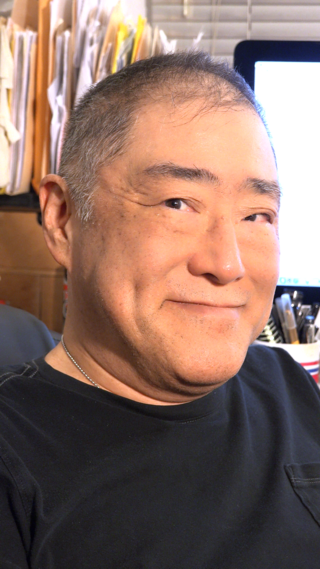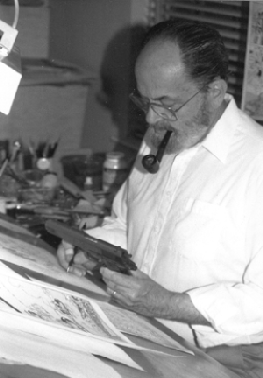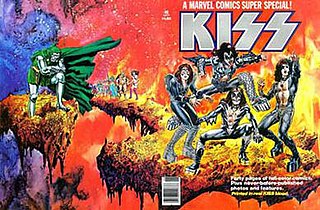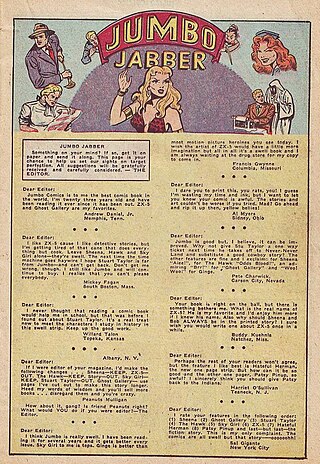
Marvel Comics is an American comic book publisher and the property of the Walt Disney Company since December 31, 2009, and a subsidiary of Disney Publishing Worldwide since March 2023. Marvel was founded in 1939 by Martin Goodman as Timely Comics, and by 1951 had generally become known as Atlas Comics. The Marvel era began in June 1961 with the launch of The Fantastic Four and other superhero titles created by Stan Lee, Jack Kirby, Steve Ditko, and many others. The Marvel brand, which had been used over the years and decades, was solidified as the company's primary brand.

James Shooter is an American writer, editor and publisher for various comic books. He started professionally in the medium at the age of 14, and is known for his successful and controversial run as Marvel Comics' seventh editor-in-chief, and his work as editor in chief of Valiant Comics.

Timely Comics is the common name for the group of corporations that was the earliest comic book arm of American publisher Martin Goodman, and the entity that would evolve by the 1960s to become Marvel Comics.

Crazy Magazine is an illustrated satire and humor magazine that was published by Marvel Comics from 1973 to 1983 for a total of 94 regular issues. It was preceded by two standard-format comic books titled Crazy. The magazine's format followed in the tradition of Mad, Sick, Cracked and National Lampoon.

Roy William Thomas Jr. is an American comic book writer and editor, who was Stan Lee's first successor as editor-in-chief of Marvel Comics. He is possibly best known for introducing the pulp magazine hero Conan the Barbarian to American comics, with a series that added to the storyline of Robert E. Howard's character and helped launch a sword and sorcery trend in comics. Thomas is also known for his championing of Golden Age comic-book heroes – particularly the 1940s superhero team the Justice Society of America – and for lengthy writing stints on Marvel's X-Men and The Avengers, and DC Comics' All-Star Squadron, among other titles.

Bob Budiansky is an American comic book writer, editor, and penciller, best known for his work on Marvel's Transformers comic. He also created the Marvel character Sleepwalker and wrote all 33 issues of that comic.

Larry Hama is an American comic-book writer, artist, actor, and musician who has worked in the fields of entertainment and publishing since the 1960s.

Johnny DC is a character that DC Comics has used at various times as a mascot for its lines of comic books, and occasionally as a metafictional character who comments on the comics in which he appears.

John Powers Severin was an American comics artist noted for his distinctive work with EC Comics, primarily on the war comics Two-Fisted Tales and Frontline Combat; for Marvel Comics, especially its war and Western comics; and for his 45-year stint with the satiric magazine Cracked. He was one of the founding cartoonists of Mad in 1952.

Not Brand Echh is a satiric comic book series published by Marvel Comics that parodied its own superhero stories as well as those of other comics publishers. Running for 13 issues, it included among its contributors such notable writers and artists as Stan Lee, Jack Kirby, Gene Colan, Bill Everett, John and Marie Severin, and Roy Thomas. With issue #9, it became a 68-page, 25¢ "giant", relative to the typical 12¢ comics of the times. In 2017, a 14th issue was released.

Herbert William Trimpe was an American comics artist and occasional writer, best known as the seminal 1970s artist on The Incredible Hulk and as the first artist to draw for publication the character Wolverine, who later became a breakout star of the X-Men.

Arthur Simek was an American calligrapher best known as a letterer for Marvel Comics during the period fans and historians call the Silver Age of Comic Books. Along with letterer Sam Rosen, Simek lettered and helped design logos for virtually all Marvel Comics published during the 1960s. Simek's work included such landmarks as The Fantastic Four #1 and Spider-Man's debut in Amazing Fantasy #15.

George D. Klein was an American comic book artist and cartoonist whose career stretched from the 1930s and 1940s' Golden Age of comic books until his death in 1969. He was best known as an inker for DC Comics, where he was an integral part of the Superman family of titles from 1955 to 1968, and for Marvel Comics, where he was the generally recognized, uncredited inker on Jack Kirby's pencil art for the landmark comic book The Fantastic Four #1.

Marvel Comics Super Special was a 41-issue series of one-shot comic-magazines published by Marvel Comics from 1977 to 1986. They were cover-priced $1.50 to $2.50, while regular color comics were priced 30 cents to 60 cents, Beginning with issue #5, the series' title in its postal indicia was shortened to Marvel Super Special. Covers featured the title or a variation, including Marvel Super Special, Marvel Super Special Magazine, and Marvel Weirdworld Super Special in small type, accompanied by large logos of its respective features.

"Bullpen Bulletins" was the news and information page that appeared in most regular monthly comic books from Marvel Comics. In various incarnations since its inception in 1965 until its demise in 2001, it included previews of upcoming Marvel publications, profiles of Marvel staff members, and a monthly column written by Stan Lee known as "Stan's Soapbox" or "Stan Lee's Soapbox".
Forbush Man is a fictional character appearing in American comic books published by Marvel Comics. Originally the mascot of Marvel's Not Brand Echh, he is the alter-ego of Irving Forbush, a fictional employee of "Marble Comics". Forbush was devised in 1955 by Marvel editor Stan Lee to refer to an imaginary low-grade colleague who was often the butt of Lee's jokes. In his guise of Forbush-Man, he first appeared in 1967.

A comic book letter column is a section of an American comic book where readers' letters to the publisher appear. Comic book letter columns are also commonly referred to as letter columns, letter pages, letters of comment (LOCs), or simply letters to the editor. Letter columns appeared early on in the history of comic books themselves, and their growing prevalence — particularly beginning in the 1960s — helped create and legitimatize comics fandom. As the forum developed, the volume and tenor of letters became a reliable gauge of overall reader response to developments in the comics themselves. Letter columns remained a regular feature of most comic books until the early years of the 21st century, when they began being phased out in favor of the growing prevalence of email and Internet forums. Despite this, the 2010s saw a renaissance of comic book letter columns, and many comics titles still print them.

Daily Planet was a promotional page appearing in DC Comics publications from 1976 to 1981. The Daily Planet contained previews of upcoming stories, as well as recurring features like "The Answer Man", where DC writer/editor Bob Rozakis would answer questions sent in by readers, and a comic strip by cartoonist Fred Hembeck which poked fun at DC characters. Edited by Rozakis, the Daily Planet was set in the format of a page from the fictional Metropolis newspaper where Clark Kent worked.

















